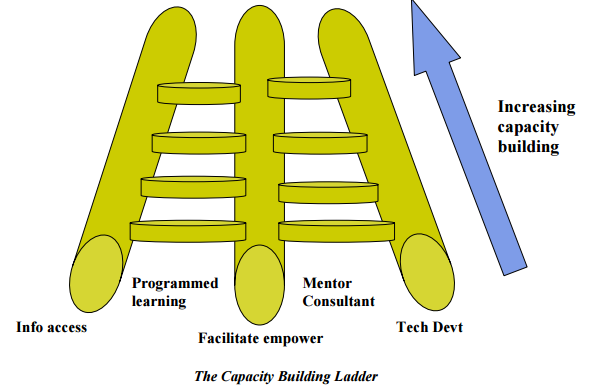Capacity Building and Community Engagement is seen as a key development in the contemporary extension space and so is described in more detail as an approach. This is in the context of recognising the constantly changing conditions in which extension takes place (i.e. changing mix of institutional, cultural, political, technological, international and governmental and other factors are affecting how extension practices play out).
Vlancaly and Leach define extension as the: “process of enabling change in individuals, communities and industries involved in the primary industry sector and with natural resource management”, (Jennings et al.,2011:3). The resource offers compiles a core body of contemporary knowledge around extension. Chapters include:
- Defining the field
- Historical development and conceptual frameworks
- Principles and Practices for Enabling Change
- Building Social Capital, and
- Economics, Policy and the Market for Extension
It provides a snapshot in the evolution of extension theories and approaches as follows:
- 1960s (Technology Transfer)
- 1970s (Farming Systems Research)
- 1980s (Systems thinking)
- 1990s (Pluralism)
- 2000s (Capacity Building and Community Engagement).
Based on the work of Coutts et al., (2005) in a review of a range of extension and education projects in the rural sector, five models of extension were distilled. These models are used to develop an evaluative framework for assessing the capacity building aspects of extension and education projects.
The five models are:
- Group Empowerment and Facilitation Model: aims to increase the capacity of participants in planning and decision making, self-efficacy in seeking learning and education opportunities, often delivered by funding a facilitator assist groups in defining their goals and learning needs and how to fulfil these needs.
- The Training Model: delivering specifically designed training programs/events to increase the understanding or skills in a defined area.
- The Technology Development/Problem-Solving Model: working with individuals and groups to develop specific technologies, management practices or decision support systems which will become an industry or public good i.e. accessed by industry and the community. Often involves local trials, demonstrations, field days and onsite visits.
- The Information Access Model: providing a range of information that individuals and groups can access at their convenience. Usually uses mass communication methods such as a website or information centre.
- The Individual Consultant/Mentor Model: individualised one-on-one support such as a technical expert on-farm visit or ongoing mentoring relationship which provides a sounding board for decision making.
All five models are integrated into a conceptual model of Capacity Building as the main purpose of extension.
Other extension leaders have suggested two further possible models:
- Multi-Stakeholder Negotiation Model: which supports collective decision-making in a complex multi-party situation, and
- Institutional Development Model: which is about the facilitation of network building, learning and negotiation processes amongst institutions, programs and networks (i.e. RD&E system actors).
The Capacity Building Ladder accentuates the complementarity of the five models and the various ways extension can be done:
- A central leg is the facilitation/empowerment model – an on-going process to maintain motivation and a framework for development and change management.
- The left leg is about information access so that individuals and groups can access the type of information in the form that they require when they need it.
- The right deals with specific technological development– incorporating learning and information into changes in new technology and practice.
- The left rungs show the need for on-going specific training/education products to allow individuals/ groups to move to the next level.
- The right rungs indicate the value in individual enterprises having iterative consultant/mentoring support for incorporating changes at an enterprise level.

Source: Coutts J and Roberts K ‘Models and Best Practice in Extension’ Project commissioned by Capacity Building for Innovation in Rural Industries Co-operative Joint Venture https://www.couttsjr.com.au/
Extension is about creating a delivery platform at the institutional level to accommodate these various models so that extension services can be provided to suit specific contexts/needs.
For Further Information
Coutts, J., Roberts, K., Forst, F and Coutts, A. (2005) Extension for capacity building: what works and why? Kingston, ACT: Rural Industries Research and Development Corporation
Source: Coutts J and Roberts K ‘Models and Best Practice in Extension’ Project commissioned by Capacity Building for Innovation in Rural Industries Co-operative Joint Venture https://www.couttsjr.com.au/
